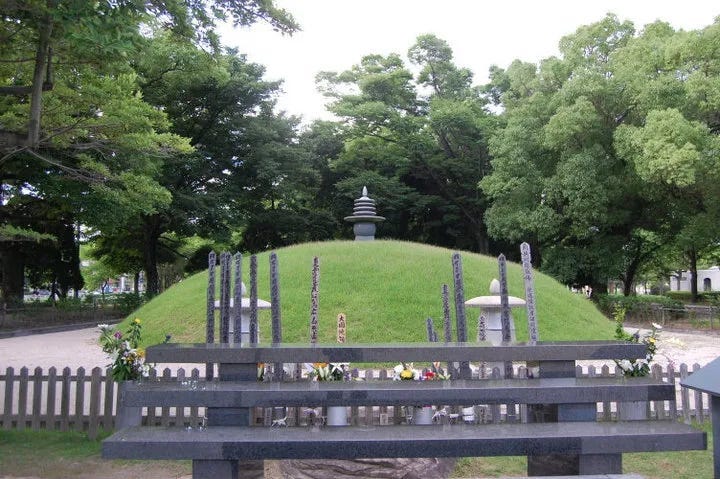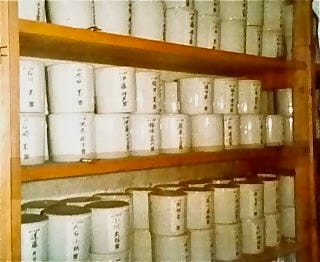Greg Mitchell is the author of a dozen books, including “Hiroshima in America,” “Atomic Cover-up,” and the recent award-winning“The Beginning or the End: How Hollywood—and America—Learned to Stop Worrying and Love the Bomb.” He has directed three documentary films since 2021, including two for PBS (plus award-winning “Atomic Cover-up”). He has written widely about the atomic bomb and atomic bombings, and their aftermath, for over forty years.
A reminder (inadequately supplied by Oppenheimer) of what happened at the other end of the bomb in Hiroshima. Based on my visit. Adapted from my book Atomic Cover-up.
In the northwestern corner of the Peace Park, amid a quiet grove of trees, the earth suddenly swells. It is not much of a mound — only about ten feet high and sixty feet across. Unlike most mounds, however, this one is hollow, and within it rests the greatest concentration of human residue in the world.
Grey clouds rising from sticks of incense hang in the air, spookily. Tourists do not dawdle here. Visitors searching for the Peace Bell, directly ahead, or the Children’s Monument, down the path to right, hurry past it without so much as a sideways glance. Still, it has a strange beauty: a lump of earth (not quite lush) topped by a small monument that resembles the tip of a pagoda.
On one side of the Memorial Mound the gray wooden fence has a gate, and down five steps from the gate is a door. Visitors are usually not allowed through that door, but occasionally the city of Hiroshima, which manages the Mound, honors a request from a foreign journalist.
Inside the Mound the ceiling is low, the light fluorescent. One has to stoop to stand. To the right and left, pine shelving lines the walls. Stacked neatly on the shelves, like cans of soup in a supermarket, are gleaming white porcelain canisters with Japanese lettering on the front. On the day I visited, there were more than a thousand cans in all, explained Masami Ohara, a city official. Each canister contained the ashes of one person killed by the atomic bomb, identified on the exterior.
Behind twin curtains on either side of an altar rest several dozen pine boxes, the size of caskets, stacked, unceremoniously, from floor to ceiling. They hold the ashes of an estimated seventy thousand unidentified victims of the bomb, according to officials. If, in an instant, all of the residents of Wilmington, Delaware, or Santa Fe, New Mexico, were reduced to ashes, and those ashes carried away to one repository, this is all the room the remains would require.
Most of those who died in Hiroshima were cremated quickly, partly to prevent an epidemic of disease. Others were efficiently turned to ash by the atomic bomb itself, death and cremation occurring in the same instant. Those reduced by human hands were cremated on makeshift altars at a temple that once stood at the present site of the Mound, one-half mile from the hypocenter of the atomic blast. The cremations were carried out by rescue workers who rarely knew the identity of the bodies they were burning. The ashes of those cremated elsewhere in the city were carted to a temporary storage site at the temple.
In 1946, an Army Air Force squad, ordered by Gen. Douglas MacArthur to film the results of the massive U.S. aerial bombardment of Japanese cities during World War II, filmed a solemn ceremony at the temple (recorded in my film, also titled Atomic Cover-up), capturing a young woman receiving a canister of ashes from a local official. Later that year, survivors of the atomic bombing began contributing funds to build a permanent vault at this site and, in 1955, the Memorial Mound was completed.
For several years the collection of ashes grew because remains of victims were still being found. One especially poignant pile was discovered at an elementary school.
The white cans on the shelves have stood here for decades, unclaimed by family members or friends. (In many cases, all of the victims’ relatives and friends were killed by the bomb.) Every year local newspapers publish the list of names written on the cans, and every year several canisters are finally claimed and transferred to family burial sites. Most of the unclaimed cans (a total of less than 800 as of 2023) will remain in the Mound in perpetuity, now that so many years have passed.
They are a chilling sight. The cans are bright white, like the flash in the sky over Hiroshima at 8:15 a.m. on August 6, 1945. From all corners of the city the ashes were collected: the remains of soldiers, but mostly physicians, housewives, the elderly, infants, and other civilians. Unclaimed, they at least have the dignity of a private urn, an identity, a life (if one were able to look into it) before death.
But what of the seventy thousand behind the curtains? The pine crates are marked with names of sites where the human dust and bits of bone were found — a factory or a school, perhaps, or a neighborhood crematory. But beyond that, the ashes are anonymous. Thousands may still grieve for these victims but there is no dignity here. “They are all mixed together,” said Ohara, “and will never be separated or identified.”
Under a mound, behind two curtains, inside a few pine boxes: This is what became of one-quarter of the city of Hiroshima on August 6, 1945.






What's worse than the story of Hiroshima is the story of the "forgotten bomb" - Nagasaki. The mission was a fuckup from takeoff to touchdown. Shortly after takeoff they found they couldn't access a fuel tank, cutting the fuel by 25%. Once over Japan, all the targets were cloud-covered. They made their run three times and were finally so short of fuel they had the choice of dropping the most expensive weapon in history in the ocean and explaining that later, or violating the ROE of the mission of visual-bombing-only.
The bombardier was operating on radar, but claimed later that a "hole" opened in the clouds long enough to drop the bomb. What did they hit?
Instead of the Mitsubishi Heavy Industries war factory, they dropped the bomb on the Urakami Catholic Church, the largest Christian church in Asia. Built entirely by donations of the parishioners, after the ban on Christianity was lifted in 1880 during the Meiji Restoration.
The B-29 then diverted to Okinawa, where they made what Jimmy Doolittle called the craziest landing he ever saw, running out of gas on the runway. The Air Force did none of the publicity they did for Enola Gay three days earlier and "Bockscar" only ended up in the Air Force Museum in the late 70s.
That Nagasaki was a target at all is proof of the moron ignorance of Americans. Nagasaki was the most anti-imperial city in Japan. It was the most pro-western city since it was created in the 15th century as the port the Spanish and Portuguese were allowed to trade in, and was the capitol of the anti-Shogun resistance in the 17th century that led to the Kyushu Rebellion that saw 250,000 Christians killed and the religion outlawed. But for the next 200 years Christianity was practiced there as an underground act of resistance. The city was where Puccini wrote "Madame Butterfly."
After the war, the people of Nagasaki determined that such an event should never happen again, and that the only way to do that was to practice and promote International Brotherhood. Proving they are better Christians than most Americans are, they dedicated the city to International Brotherhood, and to this day if you are a stranger there (I personally experienced this when I visited in 1964 while in the Navy), someone will come up to you and ask if they can help, offer to buy a meal, and even do the very un-Japanese thing of inviting a gaijin into their home.
The above is why Nagasaki is to this day little-mentioned in Official American Mythology (the accurate term for "Official History").
Not only that, the bombs did not end the war. The day Nagasaki was bombed, there was no mention of the event in the records of the Supreme War Council (which I have read). The sole topic of discussion was the USSR's entry into the war that morning. There was no defense in Manchuria, because the best units of the Kwantung Army had been transferred to Kyushu to face the coming US invasion. The Japanese expected the Soviets to take all of Manchuria and Sakhalin Island by the end of the month. They expected the Soviets to invade Hokkaido in September. There were no defenses in northern Japan at all - everything was in Kyushu. Tokyo would have been taken by late October, and perhaps all of Honshu before Operation Olympic happened. The Japanese were well aware of what the Soviets had done in Germany, and given a century of bad blood between the two countries they expected worse than that. And that is why Hirohito was prevailed upon by the "peace faction" to take an active role and end the war.
The Japanese told us the bomb ended the war, and we have been ignorant enough to base US foreign policy on a threat that can never be made good ever since. And they have been let off for all their war crimes by being The Official Victims of the war.
If you'd like to read the whole account, it's in my book "Tidal Wave."
Thank you for this first hand and very moving reminder of the horrors that nuclear weapons have wrought. This awful reality will forever be hanging over the world. They must be eliminated and these truths are part of that process.